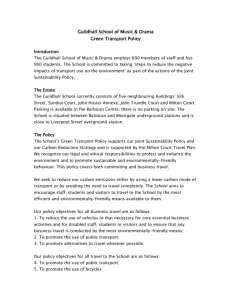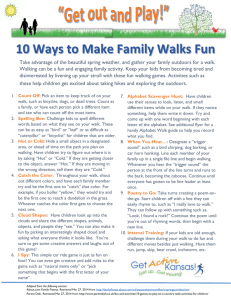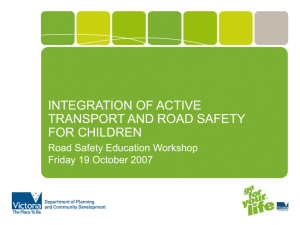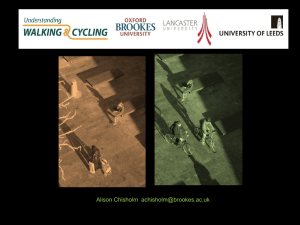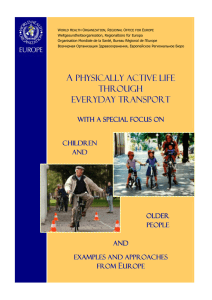Presentation to ACT Urban Development
advertisement
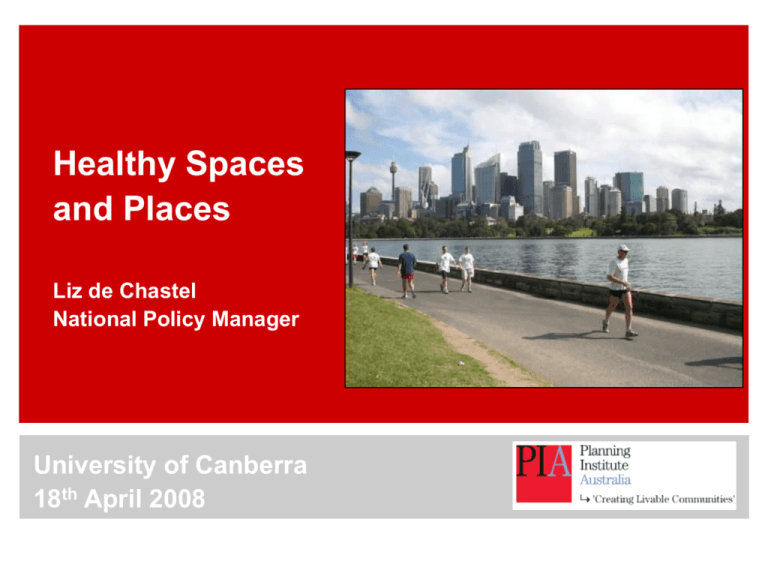
Healthy Spaces and Places Liz de Chastel National Policy Manager University of Canberra 18th April 2008 Overview • Why design for active living • Linkages between health, planning, transport and environment • Design Principles • National Project & Value of Partnerships PIA • PIA is a professional membership organisation with 4600 urban planners and related professionals; not for profit & independent • Advocate and develop policy positions on behalf of members • Planners work in Local Government (50%), Private Sector (30%) and State Govt/Academia • Planners along with others help shape our built and natural environment Health Issues around Inactivity Some facts • Physically inactive Australian adults are costing the healthcare system $1.5 billion a year • It is estimated that almost 9 million Australians – 54% of adult population – do not do enough physical activity on a daily basis • Not doing enough physical activity doubles the risk of cardiovascular disease, Type 2 diabetes, and obesity, and increases the risk of breast and bowel cancer, depression and anxiety • All it takes is 30 minutes of activity most days a week to reduce the problem (Source: Medibank Private Research 2007) Obesity and Travel Behaviour Source: Pucher J. & Dijkstra L. (2003), Promoting safe walking and cycling to improve public health: Lessons from the Netherlands and Germany, American Journal of Public Health 93: 1509 -16 Getting people out of cars Car trips in local neighbourhoods: • 10% of all car trips are less than one kilometre (the equivalent to a ten minute walk) • 30% are less than three kilometres Source: Bureau of Transport and Regional Economics (2002), Greenhouse policy options for transport, BTRE Report No 105 "Everybody would like a lively city, an attractive city, a safe city, a sustainable city and a city which invites more healthy lifestyles. By being sweet to the pedestrians and sweet to the bicyclists, you can actually accomplish quite a bit of all these goals.“ Professor Jan Gehl Relevance to Canberra • Attracting Generation Y – prefer walkable, vibrant places to live • Ageing population – ageing in place, physical and mental health • Redevelopment areas and new growth areas – offer potential • Good infrastructure in place – schools, bikeways • One Government can support co-ordination & integration • Topography and climate is conducive to active living Design Elements that promote active lifestyles Create Walkable Neighborhoods • Have legible streets and connected activities such as schools, shops • Encourage local trips to be made by walking and cycling by having direct routes to activities Plan for Walking & Cycling • Walking is free and has great health benefits - especially walking to school & local services • Walkways may be shared: walking, cycling, prams, scooters • Walking routes should be safe – road crossings, pavement surface • Cycling facilities important to encourage use – lockers, showers, maps Design for surveillance and safety • Create safe environments for activity • Perceptions of safety are a major influence for people’s willingness to be active • Pathways should also be safe to minimize falls and injuries Encourage Use of Public Transport • Well located and convenient public transport to encourage use over private vehicles • Shelters and signage important & accessibility to bus/train/tram • People that use public transport also walk to the train/bus stop Provide Passive and Active Recreation • Adequate, serviced and well located recreation areas and parklands • Multipurpose – school ovals • Private/public partnerships Promote Mixed Land-Use • Activities grouped together to minimise trips, especially residential, retail, employment, recreation and public transport • Local and regional activities • Promotes walking, cycling and the use of public transport • Local businesses also benefit Provide opportunities for interaction • Meeting Places & Public Places that support a variety of interactions between people Food Security/Agricultural Land Protection • Some States have planning policies that seek to protect good quality agricultural land – for example in Queensland with a State Planning Policy on the Protection of Good Agricultural Land • Peri-urban (fringe) areas of cities are under the most stress to convert agricultural production to housing development as cities continue to expand • Community Gardens – local community based • 100 mile diet (Canada) Food Outlets • Links between areas of socio-disadvantage and higher number of fast food outlets (VicLanes project) • Local & Regional food outlets should be well located with good pedestrian/ public transport/car access • Planning Legislation does not regulate the type of food that is sold – but can monitor the location of fast food outlets (this is done in Victoria) & may limit increasing the number of sites • Farmers markets are being promoted by many Councils • This needs more research and sharing of case studies Partnership Healthy Spaces and Places is a partnership between: • Australian Local Government Association • the Heart Foundation • Planning Institute of Australia This project has received funding assistance from the Australian Government Department of Health and Ageing Value of Partnership • Unique Partnership • Memorandum of Understanding underpins partnership • Leveraging knowledge, advocacy and networks • Stronger influence for change Project design Four project stages are identified: • Scoping – during 2007 • Consultation – workshops mid - late 2008 • Implementation – 08/09 • Evaluation - 2009 Supporting current initiatives Development of a national guide looks to complement: – – – – – NSW Premier’s Council for Active Living Victoria ‘Healthy by Design’ and ‘Go for your life’ Premier’s Physical Activity Taskforce & ‘Walk WA’ Chief Minister’s Active Living Council & ‘Go NT’ Tasmanian Premier’s Active Living Council & ‘Get Moving Tasmania’ – South Australian Active Living Coalition & ‘Be active’ – Queensland – emergent issues Healthy Spaces and Places project is about: • recognizing how everyday urban management decisions can influence people’s health and wellbeing • recognizing the complexity and crossdisciplinary/-sectoral nature of the issues • raising awareness • setting a national policy agenda • supporting current State/local initiatives What are we trying to achieve? • improved understanding amongst health and planning professionals of how the built environment influences active living • people engaging in regular physical activity • sense of belonging and social inclusion • sense of place • positive health impacts on future health burden • sustained economic well-being Consultation • Discussion draft available shortly from PIA website, with links to ALGA and Heart Foundation websites • Workshops in metropolitan and regional locations • First workshop in Adelaide on 15 May (tbc) • Also can submit comments on-line at www.planning.org.au Healthy Spaces and Places • We welcome you involvement and comments • Please contact project manager (Anne Moroney) healthyplaces@planning.org.au or 02/6262 5933
